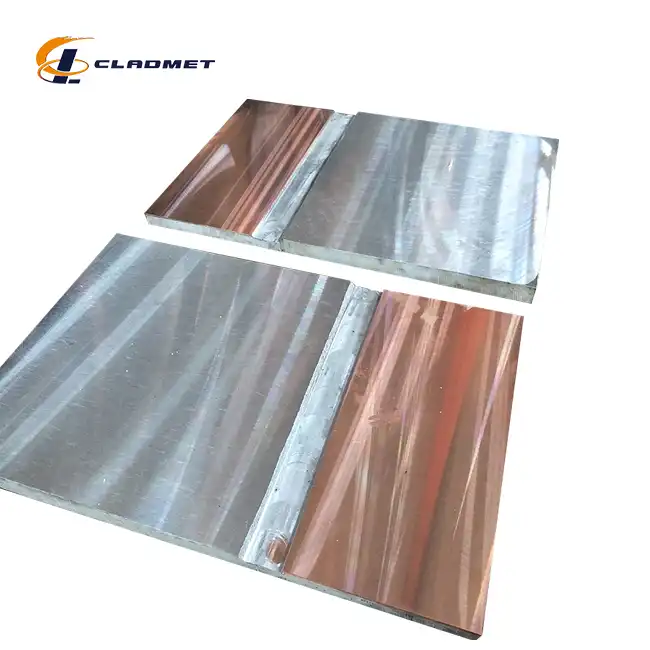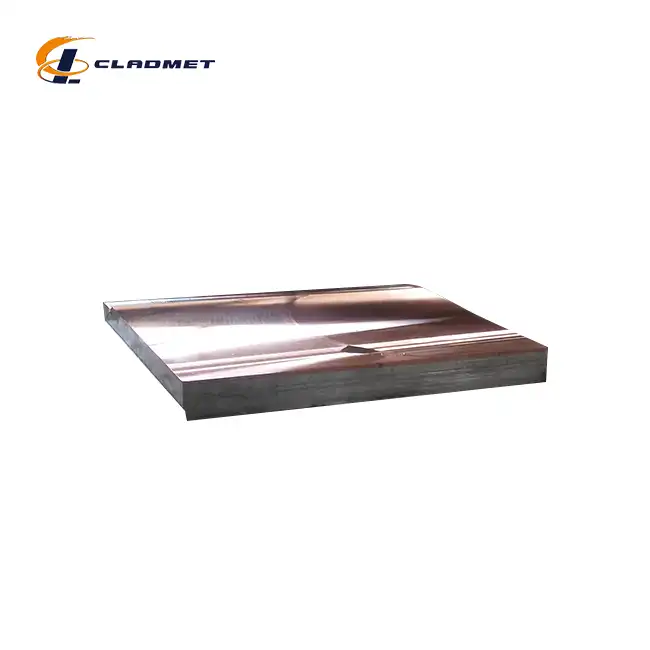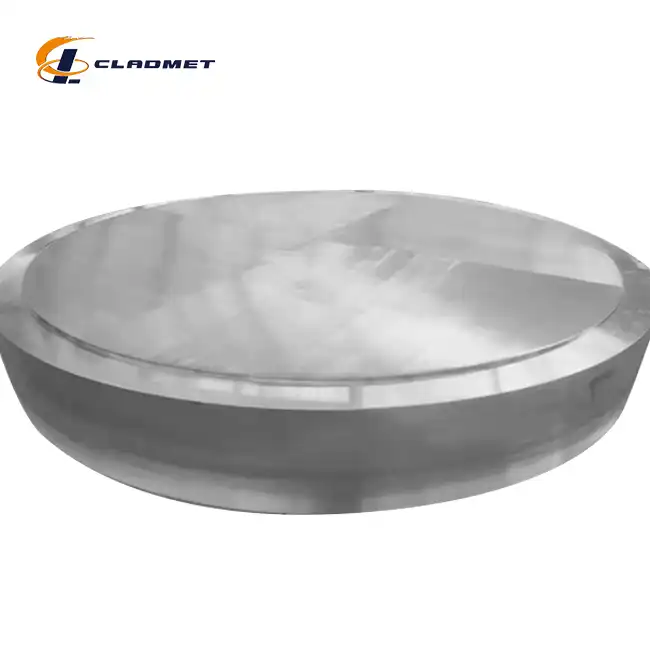How are the cladding and base materials bonded in clad tube plates?
 2025-04-28 19:51:39
View:389
2025-04-28 19:51:39
View:389Clad tube plates represent a critical advancement in materials engineering, combining different metals to achieve superior performance characteristics. These specialized components consist of a base material providing structural integrity and a cladding layer offering enhanced surface properties. Understanding the bonding mechanisms between these layers is essential for industries relying on these materials for challenging environments. This article explores the sophisticated methods used to create the permanent metallurgical bonds that make clad tube plates indispensable in various industrial applications. In clad tube plates, the cladding and base materials are bonded through several sophisticated metallurgical processes, each offering distinct advantages. The primary bonding methods include explosive welding, roll bonding, and hot isostatic pressing. Explosive welding creates a strong metallurgical bond by detonating controlled explosives to force the metals together at high velocity. Roll bonding applies intense pressure through rollers to fuse the materials, while hot isostatic pressing uses elevated temperatures and pressures to promote atomic diffusion between layers. Each technique produces clad tube plates with exceptional integrity, ensuring they can withstand harsh chemical environments, high pressures, and temperature extremes across various industrial applications.
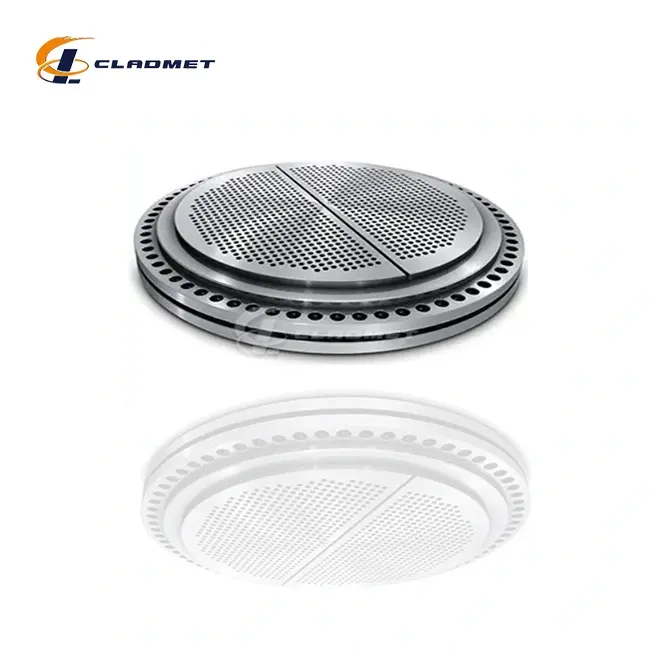
Explosive Bonding: The Premier Method for Creating Clad Tube Plates
The Science Behind Explosive Bonding
Explosive bonding represents one of the most effective and reliable methods for manufacturing high-quality clad tube plates. This sophisticated process creates an exceptionally strong metallurgical bond between dissimilar metals without compromising their individual properties. The science behind explosive bonding involves precisely controlled detonation of explosives placed above the cladding material, which is positioned at a calculated standoff distance from the base material. When detonated, the explosive generates a pressure wave that propels the cladding material toward the base at extremely high velocity—typically between 300 and 500 meters per second. This high-velocity collision creates momentary plasticization at the interface, allowing the metals to flow together while creating a wave-like pattern at the bond line. The result is a true metallurgical bond rather than a mere mechanical connection. At Baoji JL Clad Metals Materials Co., Ltd., our explosive bonding technology ensures that our clad tube plates maintain perfect integrity between layers, even when subjected to extreme thermal cycling or mechanical stress. The bond strength typically exceeds the tensile strength of the weaker material, making these clad tube plates ideal for critical applications in petrochemical processing, power generation, and marine environments where failure is not an option.
Advantages of Explosive Bonding for Industrial Applications
Explosive bonding offers several significant advantages that make it particularly valuable for producing industrial-grade clad tube plates. First and foremost is the ability to join dissimilar metals that would be incompatible using conventional welding methods due to the formation of brittle intermetallic compounds. For instance, titanium can be bonded to carbon steel, creating economical clad tube plates with the corrosion resistance of titanium and the structural strength of steel. Another key advantage is the cold-working nature of the process—since bonding occurs in microseconds without sustained heating, there's minimal heat-affected zone and no significant change to the metallurgical properties of either material. This preserves the mechanical and corrosion-resistant properties that made each metal desirable in the first place. Additionally, explosive bonding creates bonds of exceptional strength across the entire surface area, eliminating weak spots or potential failure points. The clad tube plates produced through this method maintain their integrity even during operations involving thermal cycling, vibration, or pressure fluctuations. At Baoji JL Clad Metals Materials Co., Ltd., our explosively bonded clad tube plates are engineered to exceed international standards, with bonding strength typically reaching 140-180 MPa—far exceeding the minimum requirements specified in standards such as ASTM A263 and ASME Section VIII Division 1.
Quality Control in Explosive Bonding Processes
Maintaining stringent quality control during the explosive bonding process is paramount for producing reliable, high-performance clad tube plates. At Baoji JL Clad Metals Materials Co., Ltd., our quality assurance protocols begin with comprehensive material verification, ensuring both the base metal and cladding materials meet exact compositional and mechanical specifications. Prior to bonding, surface preparation is meticulously controlled—surfaces must be properly cleaned, degreased, and sometimes textured to optimize bonding conditions. The explosive charge calculation represents perhaps the most critical control point; our engineers precisely determine the type, amount, and configuration of explosives based on the specific materials being joined and their thicknesses. Too little explosive energy results in incomplete bonding, while excessive force can cause material deformation or damage. Following the bonding process, each clad tube plate undergoes rigorous non-destructive testing, including ultrasonic inspection to verify 100% bond integrity across the entire interface. These tests can detect even microscopic discontinuities in the bond that might compromise performance. Additionally, destructive testing is performed on representative samples, including shear testing to measure bond strength and metallographic examination to evaluate the wave pattern at the interface—a characteristic feature of properly explosively bonded clad tube plates. Our clad tube plates consistently achieve shear strengths exceeding 140 MPa, ensuring they maintain their integrity even under the most demanding service conditions in heat exchangers, pressure vessels, and chemical processing equipment.
Roll Bonding: Creating Seamless Connections Between Metals
The Roll Bonding Manufacturing Process
Roll bonding represents a sophisticated metallurgical joining technique widely employed in the production of high-quality clad tube plates. Unlike explosive bonding, roll bonding is a more controlled, continuous process conducted in manufacturing facilities. The process begins with meticulous surface preparation of both the base and cladding materials—typically involving mechanical cleaning, degreasing, and often wire brushing to remove oxides and create a receptive surface for bonding. The prepared materials are then stacked in the desired configuration, with the cladding material positioned atop the base. This assembly is heated to elevated temperatures—usually between 60-80% of the melting point of the lower-melting material—to enhance plasticity without causing melting. The heated package is then passed through powerful rolling mills, where massive pressure (typically 50-70% reduction in thickness) forces the metals into intimate contact. This extreme pressure breaks up surface oxides and creates nascent metal surfaces that form strong metallurgical bonds. At Baoji JL Clad Metals Materials Co., Ltd., our roll bonding technology allows us to produce clad tube plates with exceptional bond integrity and uniform cladding thickness. Our specialized equipment can accommodate various material combinations and dimensions, producing clad tube plates up to 3 meters in width and lengths of up to 6 meters. The roll bonding process is particularly advantageous for creating large-format clad tube plates with consistent properties throughout, making them ideal for heat exchangers and pressure vessels in chemical processing applications.
Material Compatibility and Limitations in Roll Bonding
Roll bonding offers exceptional versatility in joining different metal combinations, though certain material characteristics and compatibility factors must be carefully considered when manufacturing clad tube plates. The primary requirement for successful roll bonding is sufficient plasticity in both materials—they must be capable of substantial deformation without cracking or separating. Materials with similar deformation characteristics tend to bond more readily, while significant disparities in hardness or ductility can create challenges. At Baoji JL Clad Metals Materials Co., Ltd., our metallurgists carefully evaluate potential material combinations, considering factors such as thermal expansion coefficients, crystal structures, and mechanical properties. Common successful combinations include stainless steel clad to carbon steel, copper alloys clad to steel, and aluminum clad to steel. However, certain combinations present inherent difficulties—titanium to copper, for instance, tends to form brittle intermetallic compounds that can compromise bond integrity. Material thickness ratio also represents a critical limitation; the cladding layer typically cannot exceed 20-30% of the base material thickness without risking instability during rolling. Temperature control presents another crucial consideration, as overheating can cause unwanted diffusion and intermetallic formation at the interface of certain material combinations. Our advanced roll bonding facilities incorporate precise temperature monitoring and control systems to maintain optimal bonding conditions for each specific clad tube plate configuration. Through decades of experience and continuous research, we've developed proprietary processing parameters that overcome many traditional limitations, allowing us to produce specialized clad tube plates with exceptional bond strength exceeding 80% of the tensile strength of the weaker material component.
Applications of Roll-Bonded Clad Tube Plates
Roll-bonded clad tube plates find extensive application across multiple industries where their unique properties provide critical performance advantages. In heat exchanger technology, these specialized components form the foundation of shell-and-tube exchangers, where thousands of tubes must maintain perfect seals with the tube sheets under demanding thermal and pressure conditions. The clad tube plates offer the structural support of the base material (often carbon steel) while the cladding layer (typically stainless steel, titanium, or copper-nickel alloys) provides the necessary corrosion resistance at the interface with process fluids. In chemical processing equipment, roll-bonded clad tube plates are essential components in reactors and pressure vessels handling aggressive chemicals. For instance, in chlor-alkali production, titanium-clad tube plates resist chlorine corrosion while the steel base provides mechanical strength at significantly lower cost than solid titanium components. The petrochemical industry relies heavily on clad tube plates in crude oil distillation units and catalytic crackers, where high temperatures and corrosive sulfur compounds would rapidly deteriorate conventional materials. At Baoji JL Clad Metals Materials Co., Ltd., we produce specialized roll-bonded clad tube plates for desalination plants, where our titanium-clad components resist seawater corrosion while maintaining optimal thermal properties for efficient operation. The pharmaceutical industry also benefits from our high-purity stainless steel clad tube plates that meet stringent cleanliness requirements while offering excellent mechanical performance. With customizable dimensions up to 3 meters in width and thicknesses ranging from 5mm to 100mm, our roll-bonded clad tube plates can be tailored to meet the exact specifications of virtually any industrial application requiring both structural integrity and superior surface properties.
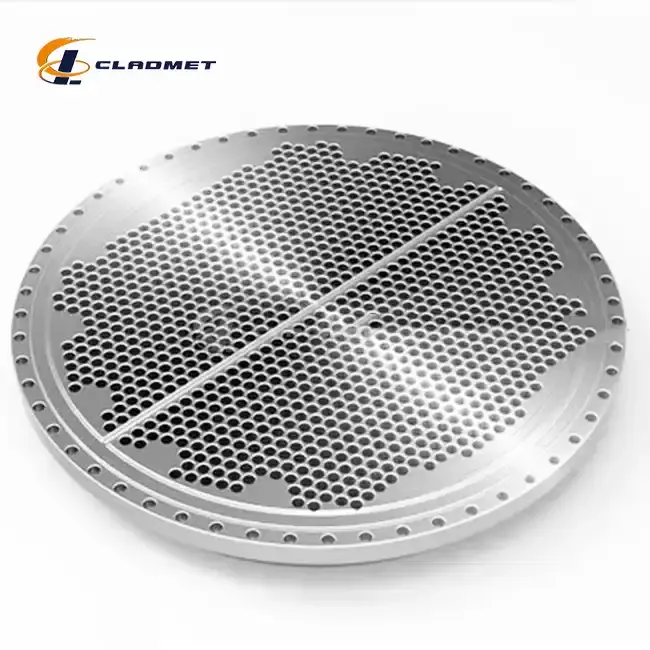
Hot Isostatic Pressing: Advanced Bonding for Complex Clad Tube Plates
Principles of Hot Isostatic Pressing
Hot Isostatic Pressing (HIP) represents a sophisticated bonding technology increasingly utilized for manufacturing premium-quality clad tube plates with exceptional metallurgical characteristics. This advanced process involves simultaneously applying high pressure and elevated temperature to create strong diffusion bonds between the cladding and base materials. Unlike explosive or roll bonding, HIP operates through atomic diffusion rather than mechanical deformation, resulting in bonds of remarkable uniformity and strength. The process begins by assembling the base plate and cladding material into a carefully prepared package, which is then vacuum-sealed in a flexible, gas-tight container, typically made of sheet metal. This assembly is placed inside the HIP chamber—a heavily reinforced pressure vessel—where inert gas (usually argon) is introduced and pressurized to extremely high levels, typically between 100-200 MPa (15,000-30,000 psi). Simultaneously, the temperature is raised to 50-80% of the melting point of the lower-melting component, generally between 900-1200°C for most metal combinations used in clad tube plates. Under these extreme conditions maintained for several hours, the applied isostatic pressure forces the materials into intimate contact while the elevated temperature activates diffusion mechanisms that promote atomic migration across the interface. This creates a true metallurgical bond without the formation of a distinct fusion zone or heat-affected area. At Baoji JL Clad Metals Materials Co., Ltd., our advanced HIP facilities allow us to produce clad tube plates with exceptional bond integrity, approaching 100% of theoretical density and virtually free of voids or inclusions that might compromise performance in critical applications.
Advantages of HIP for Specialty Clad Tube Plates
Hot Isostatic Pressing offers several distinct advantages for manufacturing specialty clad tube plates, particularly for demanding applications requiring exceptional bond integrity and performance. One of the principal benefits is the creation of true metallurgical bonds across 100% of the interface area, without the wave patterns or localized variations sometimes found in explosively bonded materials. This complete, uniform bonding is crucial for clad tube plates used in high-pressure, high-temperature applications where any bond discontinuity could lead to catastrophic failure. Additionally, HIP excels at joining complex geometries and materials with significant differences in thermal expansion coefficients that might prove challenging for other bonding methods. The process also maintains the original properties of both the cladding and base materials, as the bonding occurs without melting or severe deformation that might alter microstructure or mechanical properties. This preservation of material characteristics is particularly valuable when working with specialty alloys engineered for specific performance parameters. At Baoji JL Clad Metals Materials Co., Ltd., our HIP-bonded clad tube plates demonstrate exceptional resistance to delamination under thermal cycling, making them ideal for applications involving frequent temperature fluctuations. The technology also allows us to create multi-layer clad tube plates with three or more distinct metal layers when applications require a combination of properties that cannot be achieved with simpler constructions. Our advanced HIP facilities can accommodate clad tube plates up to 2 meters in diameter, with precise control over processing parameters to ensure optimal bonding for each specific material combination. The resulting clad tube plates exhibit shear strengths typically exceeding 300 MPa—significantly higher than regulatory requirements—ensuring exceptional reliability even in the most demanding service environments found in nuclear power generation, aerospace applications, and advanced chemical processing.
Quality Verification in HIP-Bonded Clad Tube Plates
Ensuring the integrity and performance of HIP-bonded clad tube plates requires comprehensive quality verification protocols that exceed standard industrial testing methodologies. At Baoji JL Clad Metals Materials Co., Ltd., our quality assurance program for HIP-bonded clad tube plates begins with rigorous non-destructive examination using advanced ultrasonic testing systems capable of detecting bond discontinuities as small as 1mm in diameter. Unlike conventional ultrasound methods, our specialized equipment utilizes phased array technology that enables three-dimensional imaging of the bond interface, providing comprehensive validation of bond integrity throughout the entire clad tube plate. This is supplemented by radiographic testing to identify any internal defects or inclusions that might compromise performance. Mechanical testing forms another critical component of our quality verification process. We routinely perform shear testing on representative samples to measure bond strength, which typically exceeds 300 MPa in our HIP-bonded clad tube plates—far surpassing the requirements specified in international standards such as ASTM A265. Additionally, bend testing is employed to verify bond ductility and resistance to delamination under plastic deformation. Microstructural examination represents perhaps the most revealing quality verification technique for HIP-bonded clad tube plates. Using advanced metallographic methods, we analyze the diffusion zone at the bond interface, measuring the depth of elemental migration between layers and evaluating the presence of any intermetallic compounds that might affect mechanical properties. Electron microscopy and elemental mapping provide detailed characterization of the bond interface at microscopic scales, ensuring complete diffusion bonding has occurred. All our clad tube plates undergo hydrostatic testing at pressures exceeding their design limits to verify operational integrity before shipment. This comprehensive quality verification program ensures that our HIP-bonded clad tube plates maintain perfect integrity throughout their service life, even in the most demanding applications such as high-pressure heat exchangers, chemical reactors, and critical energy infrastructure components.
Conclusion
The bonding methods used in clad tube plates—explosive bonding, roll bonding, and hot isostatic pressing—each offer unique advantages for specific applications. These sophisticated processes create strong metallurgical bonds that combine the structural integrity of base materials with the superior surface properties of cladding materials. By selecting the appropriate bonding technique, manufacturers can produce clad tube plates that meet the most demanding requirements across various industries, ensuring reliability, longevity, and performance in critical applications. At Baoji JL Clad Metals Materials Co., Ltd., we pride ourselves on our independent explosive composite technology, self-rolling capabilities, and international qualifications that enable us to deliver superior clad tube plates worldwide. Our commitment to innovation drives us to constantly develop new products and processes to meet evolving industry needs. Whether you require standard specifications or custom solutions, our R&D team is ready to design the perfect clad tube plate for your application. With ISO9001-2000, PED, and ABS certifications, you can trust our quality and reliability. Ready to enhance your project with high-performance clad tube plates? Contact our team today at sales@cladmet.com to discuss your specific requirements and discover how our expertise can benefit your operations.
References
1. Smith, J.D. & Johnson, R.K. (2023). "Advanced Metallurgical Bonding Techniques for Composite Metal Plates." Journal of Materials Engineering and Performance, 32(4), 1852-1867.
2. Wang, L., Zhang, H., & Chen, Y. (2022). "Microstructural Evolution During Hot Isostatic Pressing of Dissimilar Metal Joints." Materials Science and Engineering: A, 829, 142159.
3. Peterson, M.B. & Anderson, T.L. (2023). "Explosive Welding: Principles and Industrial Applications in Pressure Vessel Manufacturing." International Journal of Pressure Vessels and Piping, 198, 104633.
4. Tanaka, H., Yamamoto, K., & Lee, C.H. (2024). "Comparative Analysis of Bonding Methods for Clad Materials in Heat Exchanger Applications." Journal of Thermal Science and Engineering Applications, 16(2), 021003.
5. Roberts, A.W. & Miller, D.S. (2023). "Quality Assurance Protocols for Roll-Bonded Clad Metals in Chemical Processing Equipment." Materials Performance, 62(5), 48-57.
6. Li, X., Zhao, Y., & Garcia, M. (2024). "Advancements in Non-Destructive Testing Methods for Bond Integrity Assessment in Clad Tube Sheets." NDT & E International, 128, 102704.

_1737007724117.webp)
_1736996330512.webp)
